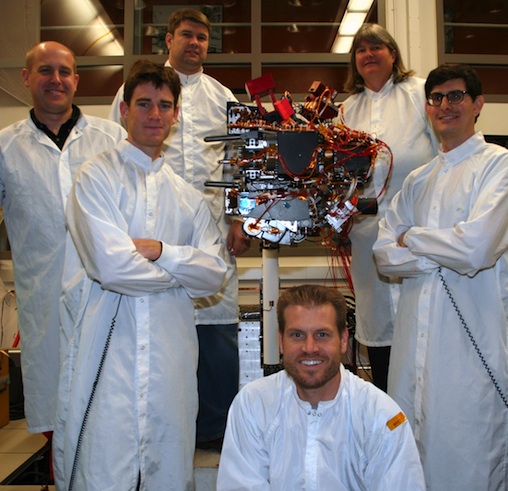The Mars rover Curiosity is on a mission to deliver what scientists hope will be groundbreaking scientific research that wouldn't be possible without robotics,according to a NASA chief engineer.
"It's critical to this mission,"said Louise Jandura,sampling system lead engineer with NASA's Jet Propulsion Laboratory."Robotics is a key component of the mobile robotic laboratory,in terms of being able to rove,to move around and drive.We're mobile and we can use the robotic arm to reach out and touch targets.It's all key."

NASA scientists(clockwise from upper right)Louise Jandura,Avi Okon,Brett Kennedy,Dan Sunshine,Joe Melko and Matt Orzewalla worked with the robotic arm on a testbed rover,a twin to Curiosity.This testbed rover was not sent to Mars.(Photo:NASA/JPL)
Curiosity,a$2.5 billion,car-size rover,landed on Mars on Aug.6.Tasked with a two-year mission to discover if Mars has ever been capable of sustaining life,the rover is carrying 10 scientific instruments,a 7-foot robotic arm and the ability to drive across the Martian surface.
Curiostiy is NASA's largest,most expensive and best-equipped rover to be sent into outer space,but the rover is dependent on its robotics to get its job done.
"It's extraordinary,"said Jandura."It's joyous,not only because of seeing the success of something that we've poured a lot of time and effort into,but it presents the ability to go and explore a world we don't live in quite yet."
Jandura noted that Curiosity represents robotics on a larger scale than the space agency has ever taken on with a rover."Curiosity is a Range Rover size robotic laboratory,"she told Computerworld."All the robotics on it are equally scaled up from[its Mars rover predecessors]Opportunity and Spirit."
NASA's Spirit and Opportunity rovers have been two of the agency's most successful robotic projects.While Spirit was given up for dead last year,both rovers worked on the Martian surface for more than six years--far longer than the three months that NASA initially expected them to last.
However,the rover Opportunity is still working.It was upgraded with artificial intelligence software to enable the robot to make some of its own decisions about what rocks or geological formations it should stop and analyze.
Both Spirit and Opportunity were equipped with two-and-a-half-foot-long robotic arms,while Curiosity's is 7 feet.Jandura noted that the arm configurations are similar but the new arm is stronger and rigged with better tools.
Spirit and Opportunity,for instance,carried an abrasion tool designed to grind rock surfaces.The older rovers made observations but weren't able to collect samples.
Curiosity has a drill on its arm so powerful that it can turn a rock into powder.It also can collect the powder,sort it into larger and smaller particles and deliver the smaller pieces to the rover's analysis instruments.
Curiosity's mast,which holds several cameras,also is equipped with robotic joints,enabling it to move,take high-resolution color images and video.
There also are robotic joints in the rover's six wheels.
"We can tell the rover to drive using its wheel system and,based on images taken by its cameras,the rover can avoid obstacles,"said Jandura.
She added that NASA engineers were able to improve the robotics in Curiosity based on what was learned from the earlier two rovers.
"Every time we take the step of building a rover to go to another planet...we've taken the lessons we've learned from one and use them in another,"said Jandura."We learned how to scale it up to be bigger and more capable."
She also was quick to add how much she loves her job these days.
"I'm still amazed when I look up in the sky and see the little dot that is Mars,"she said."To think that at night I see Mars and then I go to work and get to see Mars close up with all these cameras and all these instruments that analyze the planet.It's phenomenal."





